|
|
|
|
Almost three years ago, the National Inquiry into Missing and Murdered Indigenous Women and Girls released its final report and among its findings, the report identified resource extraction as a site of gender violence.
The relationship between extraction and gender violence has been observed in extractive sites around the globe. And in Canada, this gender violence is shaped by extraction and settler colonial dispossession of Indigenous lands and livelihoods.
Today in The Conversation Canada, Rebecca Hall of Queen’s University talks about her research and new book, Refracted Economies: Diamond Mining and Social Reproduction in the North, where she spoke with Dene, Métis, Inuit and non-Indigenous women in the Northwest Territories about their experiences with the mines.
She says, “The women I spoke with shared concerns that inequalities in both caring labours and finances were shaping conditions for interpersonal violence, and making it more difficult for women to leave violent situations.”
Also today:
All the best.
|

|
Haley Lewis
Culture + Society Editor
|
|
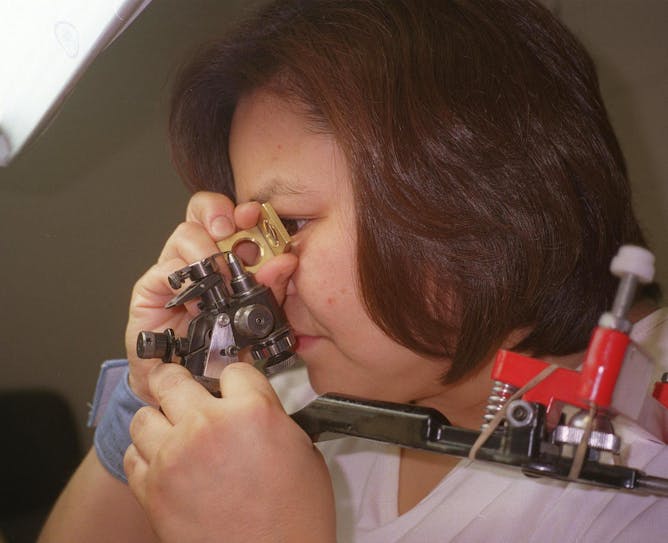
A woman examines a diamond she is in the process of cutting and polishing in Yellowknife, N.W.T. in a photo from 2003.
(CP PHOTO/Bob Weber)
Rebecca Hall, Queen's University, Ontario
While marketing has made diamond rings a symbol of heteronormative happy endings, women from the Northwest Territories tell a different story about their experiences with the diamond mines.
|

Russian President Vladimir Putin delivers his speech during the Victory Day military parade in Moscow, Russia, on May 9, 2021, marking the 76th anniversary of the end of the Second World War in Europe.
(Mikhail Metzel, Sputnik, Kremlin Pool Photo via AP)
Oleksa Drachewych, Western University
Russia’s take on the Second World War is not merely for nationalist consumption. The actions of the Soviet Union in defeating Nazi Germany appear to be a blueprint for the Russian attack on Ukraine.
|
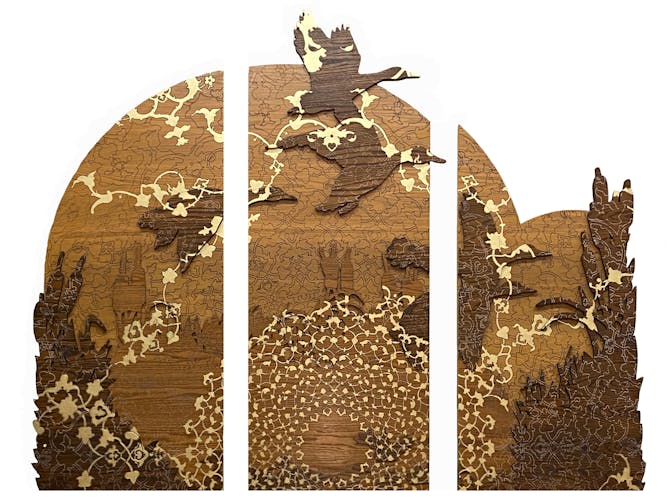
Canada geese and mallards at sunset, laser-etched with a pattern from sections of mosaic design of the Imam Mosque in Isfahan, Iran, seen in ‘Mallards Reeds’ by artist Soheila Esfahani.
(Soheila Kolahdouz Esfahani)
Soheila Kolahdouz Esfahani, Western University
As Islamic geometric patterns and arabesque designs have migrated globally, they’ve been adapted, and may not even be recognized as bearing the influence of Islamic societies.
|
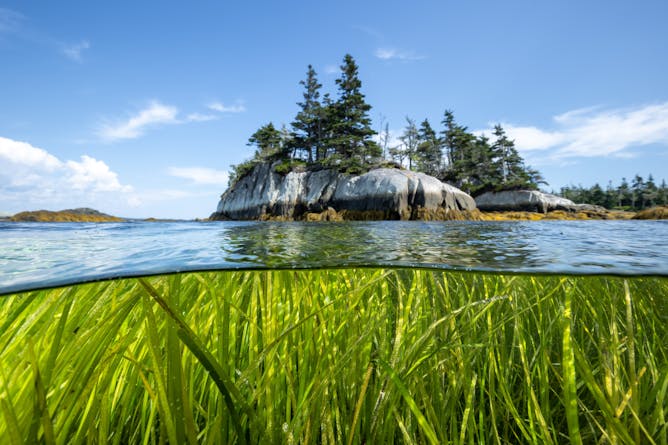
Marine ecosystems across Canada’s coasts, such as eelgrass meadows that provide an important habitat for juvenile species, are threatened by human activities and climate change.
(Nicolas Winkler)
Andrea Bryndum-Buchholz, Memorial University of Newfoundland; Kristina Boerder, Dalhousie University
It is time to acknowledge and address the rapid shifts in Canada’s oceans. To meet this challenge, Canada’s marine conservation toolbox — starting with the Oceans Act — needs an overhaul.
|

A lawsuit filed on April 12 alleges that Tesla CEO Elon Musk illegally delayed disclosing his stake in Twitter so he could buy more shares at lower prices.
(AP Photo/Susan Walsh, File)
Jaigris Hodson, Royal Roads University
Elon Musk’s attempt to take over Twitter uses free speech as the motivation, but research shows that unregulated online spaces result in increased harassment for marginalized users.
|
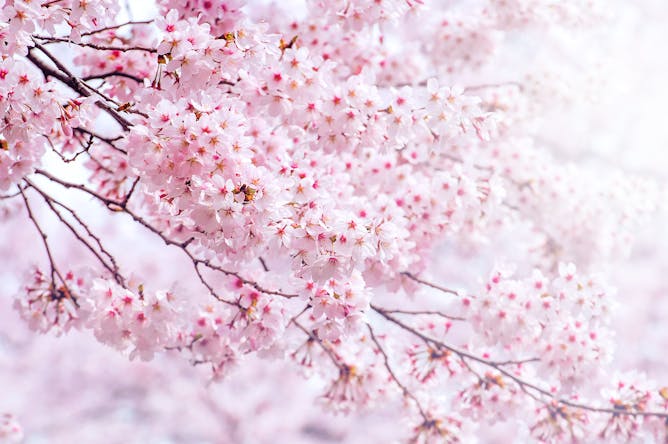
Changes in climate affect the timings of various points in the life cycle of plants, including when flowers bloom in spring and when leaves wither in autumn.
(Shutterstock)
Roberto Silvestro, Université du Québec à Chicoutimi (UQAC); Sergio Rossi, Université du Québec à Chicoutimi (UQAC)
Climate change is modifying the timing of recurrent life-cycle events with critical consequences on ecological and economic levels.
|
La Conversation Canada
|
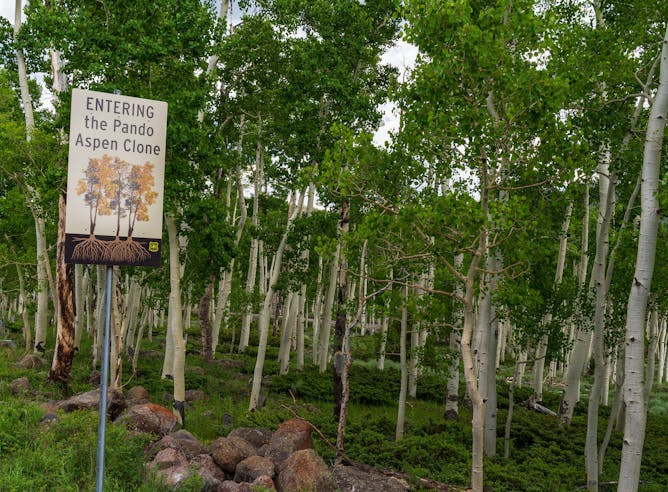
Pando, le plus grand organisme vivant de la planète, risque de disparaître après des millénaires de vie à cause du surpâturage des cerfs et des wapitis.
(Lance Oditt/Friends of Pando)
Richard Elton Walton, Newcastle University
Ces 47 000 peupliers faux-trembles sont des clones génétiquement identiques avec des racines communes.
|
Ukraine Invasion
|
-
Rory Finnin, University of Cambridge; Thomas D. Grant, University of Cambridge
When it comes to Russia’s invasion and violence against Ukraine, language matters.
-
Jonathan Este, The Conversation; Matt Warren, The Conversation
A digest of the week’s coverage of the war against Ukraine.
-
Jennifer Mathers, Aberystwyth University; Allyson Edwards, University of Warwick
Russian schoolchildren are being mobilised in a patriotic movement which encourages military service.
|
|
Podcasts
|
-
Daniel Merino, The Conversation
From the archive: researchers visited the remote Kalash valleys to investigate how the concept of ‘happy’ and ‘sad’ music differs across cultures. Listen to The Conversation Weekly podcast.
|
|
Arts
|
-
Arielle Baskin-Sommers, Yale University
Cartoon villains on TV crime shows obscure the huge social and personal costs of psychopathy, as well as the encouraging new science that can help treat it.
|
|
Culture + Society
|
-
Holly Thorpe, University of Waikato; Allison Jeffrey, University of Alberta; Simone Fullagar, Griffith University
Women have found innovative and powerful ways to cope during the pandemic – largely because official policy has failed them. That must change.
|
|
Environment + Energy
|
-
Grazia Pacillo, CGIAR System Organization; Ana Maria Loboguerrero, CGIAR System Organization; Elisabeth Gilmore, Carleton University; Peter Läderach, CGIAR System Organization; Tanaya Dutta Gupta, CGIAR System Organization
Under certain conditions, climate can amplify security risks, with implications for lasting peace.
|
|
Politics
|
-
Gabriella Gricius, Colorado State University
The Arctic Council was the world’s primary forum for cooperation among the eight Arctic nations and a channel for diplomacy – until Russia launched a war.
|
|
|
|
| |
| |
| |
| |
|
|
|
|
|
|
|